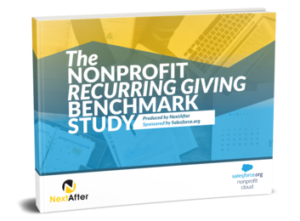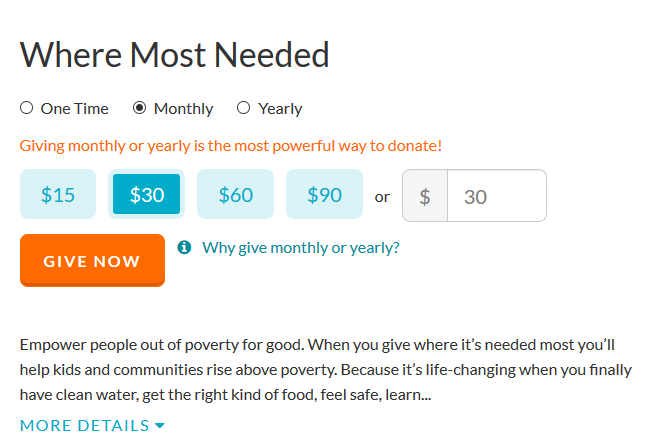How to Attract, Convert, Cultivate, and Retain More Recurring Donors
7 Sobering Recurring Donor Statistics, and the Action Steps You Need to Take In Response
 The Nonprofit Recurring Giving Benchmark Study from NextAfter contains some eye-opening data about how nonprofits could be doing a lot more to attract, convert, cultivate, and retain more recurring donors.
The Nonprofit Recurring Giving Benchmark Study from NextAfter contains some eye-opening data about how nonprofits could be doing a lot more to attract, convert, cultivate, and retain more recurring donors.
Here’s a rundown of some key stats and the action steps you can take based on this data.
How to ATTRACT More Recurring Donors
Key Statistic: 1 in 10 nonprofits has no online option for making recurring donations.
If you don’t even give them the option to do so, you aren’t going to get very many donors to give monthly. Giving monthly should be as easy as giving a one-time gift. According to the study, the only way to give monthly to some organizations was to call them.
Marketing 101 – make it as easy, simple, and clear as possible for prospects to take your desired action.
Not even having an option to give monthly, or creating undue burden by requiring a phone call, makes giving monthly hard, complicated, time-consuming, and unclear.
Action Step: If you have no online option for collecting recurring donations, make one, even if it’s just a simple checkbox for now. The screen capture from World Vision’s donation page offers a great example of how easy this is.

Key Statistic: 75% of nonprofits don’t have a separate call-to-action for recurring donations on their homepage.
Creating a separate pathway for making recurring donations accomplishes several things:
- – Gives donors who want to give monthly the clearest pathway for doing so
- – Allows you to create additional messaging around the value of recurring gifts
- – Makes it clear from the outset that you value and depend on recurring donors
Action Step: Create a recurring donation pathway and a second donate button on your homepage.
How to CONVERT More Recurring Donors
Key Statistic: Only 14% of nonprofits ask one-time donors to upgrade to monthly giving
In the business world, they call this the ‘upsell,’ and it’s critical to increasing revenue. It’s no different for nonprofits, which are also businesses. (If you resist viewing your nonprofit as a business – read this)
Your upsell for one-time online donors should be to upgrade to recurring giving. There are several ways you can do this:
1. Include recurring giving copy on your main donation page
Just a few lines of messaging can communicate how much more impact the donor will have if they choose to give monthly – even if that monthly amount is less than they were planning to give.
2. Use a popup after the donor has clicked to send their money
After the donor has clicked to send their donation, you can set up your CRM (if yours can do this) to trigger a popup. The popup can then offer the donor the chance to upgrade to recurring giving. It should include copy to incentivize this. (A CRM is a Customer Relationship Management software platform. It’s your backend support system).
Here you have a captive audience, someone who has already chosen to give. This means you’ve already won their support. So it’s a perfect time to ask them to give on an ongoing basis. The worst they can do is say no, and you still get their one-time gift.
The study’s authors tested this, and found a 64% increase in recurring donors when using this method.
64%! You want some of that?

3. Ask for recurring donations on your thank you page
If your CRM can’t do the popup option, maybe it can do this. After they give, use the thank you page as an opportunity to ‘sell’ them on recurring giving.
If they decide to give monthly, provide a button where they can go back in and change their donation to recurring.
The authors of the study are unequivocal about how important your copy is to getting more recurring donors:
“The most effective tool that we have to show donors the value of a gift is our copy. Use messaging around your recurring donation option that clearly communicates why a recurring gift is valuable and has a much greater impact on your organization and cause.”
Action Step: Use copy to motivate more donors to choose to give monthly, and use one or more of the three options above to deliver it.
Need fundraising copywriting help?
Schedule a free call with ProActive Content
How to CULTIVATE More Recurring Donors
Key Statistic: 91% of nonprofits stop acknowledging recurring gifts by the third month
You must persist in communicating the impact your donors’ gifts are having on the cause they – not just you – care about.
The study has a lot more to say about this, and how communication with recurring donors rarely differs from what one-time donors receive. It should. This is a missed opportunity to make your recurring donors feel extra special and extra vital to the success of your cause. And they are!
The impact of a recurring donor IS far greater than that of a one-time donor. We need to tell them this and thank them for the outsized impact their giving is having on the world.
Action Step: Develop targeted and ongoing communication exclusively for your recurring donors.
How to RETAIN More Recurring Donors
Key Statistic: 24% of nonprofits make no attempt to win back the donor when their credit card number changes
Key Statistic: 47% don’t reach out even when the credit card gets cancelled
Just tragic. To have a donor who gives every month cheerfully, and then lose them because you don’t follow up when their credit card changes, is a terrible loss.

Many credit card processors can incorporate automated tools that will update lost or changed credit card numbers. It’s worth it to spend some time on this, right? How much is one recurring donor worth to you over a year? Over five years? Taking some time to set this up should be a top priority.
But there’s an even better way, and most nonprofits aren’t doing this either:
Key Statistic: Only 33% of nonprofits accept EFT, Bank Draft, or ACH payments
Why is direct withdrawal from the donor’s bank a better approach? Because credit card numbers get changed frequently, but bank accounts rarely do. According to the study, credit card numbers change every nine months, on average. But bank account numbers change every 16 years.
Action Step: Get your donors to give directly from their bank accounts instead of their credit card. It’s far less likely to drop off, and the fees are often lower for this option as well.
Want more content? Get weekly nonprofit fundraising and copywriting tips, strategies, and motivations in the ProActive Insights newsletter.

